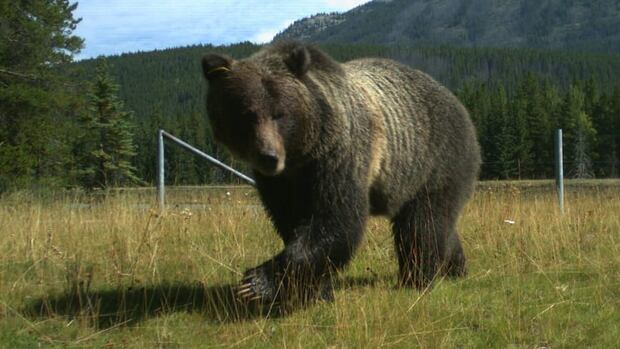High-tech grizzly monitoring beats picking up bear poop, Parks Canada finds
New method using GPS collars and wildlife cameras finds bear population steady in Banff, Kootenay and Yoho
Parks Canada employees used to collect bear poop and tufts of hair from the remote backcountry and test the samples for DNA in order to monitor grizzly populations, but now they're using a much faster — and cheaper — method to keep tabs on the animals.
The technique involves a combination of GPS data from bears that have been fitted with tracking collars and photos from automated wildlife cameras distributed throughout the mountain parks of Banff, Kootenay and Yoho.
Wildlife ecologist Jesse Whittington said the collars and cameras were already being used for other studies, but putting them together in this way to study population density is new.
"What we're really excited about is we feel this technique could be applied to wildlife populations around the world," he said.
"There's a lot of radio-collaring studies out there and the use of remote cameras is just exploding exponentially around the world because they're non-invasive and they're relatively inexpensive."
His research team's work was recently published in the Journal of Applied Ecology.
Whittington said a grizzly bear population survey was done between 2006 to 2008 using the old method of DNA collection and Parks Canada was considering doing another one a few years ago but it would have cost about $500,000.

"That's a great way to monitor populations, but it's very expensive and labour intensive," he said.
"Those studies are especially difficult in remote wilderness areas like Banff National Park."
Using the new, high-tech method, Whittington's team estimated the bears' population density to be stable at about 13 grizzlies per 1,000 square kilometres in the mountain parks.
That came as welcome news to Jodi Hilty, president and chief scientist with the Yellowstone to Yukon Conservation Initiative, a non-profit organization that works in both Canada and the U.S. to protect natural habitats.
"To me it's really exciting that these animals are doing well and they're maintaining their population at a seemingly stable level," she said.
"That's really important to a park like Banff because there are so many visitors — it's increasing every year — and with the other stressors like climate change in this system, it's really important that we know what's going on with species like grizzly bears and many other animals that might be affected by these things."
- MORE BANFF NEWS | Wild bison calves born in Banff National Park 'a huge step' to reintroduction
- MORE BANFF NEWS | Banff tourist bonanza spilling out beyond the park gates
With files from Kate Adach
